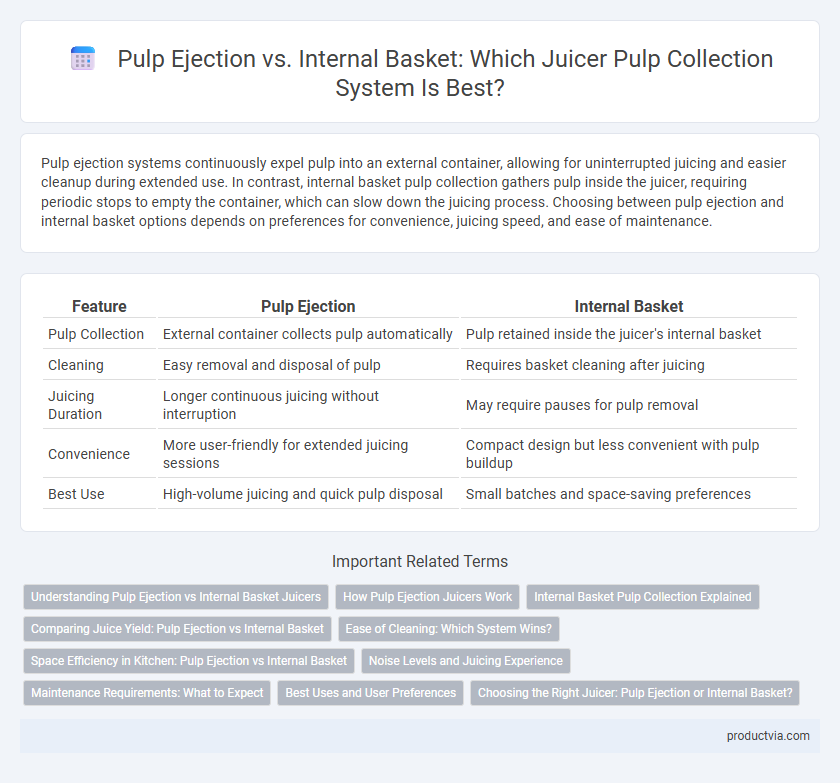Pulp ejection systems continuously expel pulp into an external container, allowing for uninterrupted juicing and easier cleanup during extended use. In contrast, internal basket pulp collection gathers pulp inside the juicer, requiring periodic stops to empty the container, which can slow down the juicing process. Choosing between pulp ejection and internal basket options depends on preferences for convenience, juicing speed, and ease of maintenance.
Table of Comparison
| Feature | Pulp Ejection | Internal Basket |
|---|---|---|
| Pulp Collection | External container collects pulp automatically | Pulp retained inside the juicer's internal basket |
| Cleaning | Easy removal and disposal of pulp | Requires basket cleaning after juicing |
| Juicing Duration | Longer continuous juicing without interruption | May require pauses for pulp removal |
| Convenience | More user-friendly for extended juicing sessions | Compact design but less convenient with pulp buildup |
| Best Use | High-volume juicing and quick pulp disposal | Small batches and space-saving preferences |
Understanding Pulp Ejection vs Internal Basket Juicers
Pulp ejection juicers continuously expel pulp through a chute, allowing for uninterrupted juicing and easy disposal, which is ideal for high-volume juicing. Internal basket juicers collect pulp inside a built-in container, requiring periodic stopping to empty the pulp but often providing a more compact design. Choosing between pulp ejection and internal basket depends on preferences for convenience, juicing speed, and kitchen space.
How Pulp Ejection Juicers Work
Pulp ejection juicers use centrifugal force to separate juice from the pulp, automatically expelling the pulp through a dedicated chute into an external container, allowing continuous juicing without stopping. These juicers feature a built-in system that collects and ejects pulp immediately, reducing clogging and simplifying cleanup compared to internal basket designs, where pulp accumulates inside the machine. The efficient pulp ejection mechanism enhances juicing speed and convenience, making them ideal for high-volume juice extraction.
Internal Basket Pulp Collection Explained
Internal basket pulp collection in juicers efficiently separates juice from fibrous pulp, using a fine mesh basket that traps pulp inside the compartment. This method ensures continuous juicing without frequent stops for pulp disposal, enhancing convenience and juice yield. The internal basket design also promotes easier cleanup compared to external pulp ejection systems.
Comparing Juice Yield: Pulp Ejection vs Internal Basket
Pulp ejection juicers typically deliver higher juice yield by continuously expelling pulp, preventing clogging and ensuring more efficient extraction from fruits and vegetables. Internal basket juicers collect pulp inside a chamber, which can reduce juice output due to frequent pauses required for emptying and potential pulp accumulation. Comparing juice yield, pulp ejection models optimize extraction efficiency, making them ideal for high-volume juicing with minimal interruptions.
Ease of Cleaning: Which System Wins?
Pulp ejection systems offer straightforward cleaning by automatically expelling pulp into an external container, minimizing direct contact and reducing residue buildup inside the juicer. Internal basket systems require manual removal and thorough washing of the pulp basket, often necessitating extra effort to clean tight mesh filters. For ease of cleaning, pulp ejection juicers typically provide a more user-friendly experience with less time spent on maintenance and disassembly.
Space Efficiency in Kitchen: Pulp Ejection vs Internal Basket
Pulp ejection juicers offer superior space efficiency in the kitchen by automatically expelling pulp into an external container, eliminating the need for frequent interruptions. Internal basket juicers require manual removal of the pulp container, which can be bulky and occupy counter space during juicing sessions. The compact design of pulp ejection models streamlines the juicing process while maintaining a tidy kitchen environment.
Noise Levels and Juicing Experience
Pulp ejection systems expel pulp directly into an external container, reducing noise levels by minimizing internal pressure and friction during juicing. Internal basket pulp collection traps pulp inside the juicer, often creating louder operation due to pulp buildup and increased motor strain. Choosing pulp ejection enhances a quieter and smoother juicing experience, while internal baskets may require frequent cleaning and generate more operational noise.
Maintenance Requirements: What to Expect
Pulp ejection juicers require regular emptying of the external pulp container to prevent overflow and maintain efficient operation, demanding frequent attention during extended juicing sessions. Internal basket juicers collect pulp inside the machine, necessitating thorough cleaning after each use to remove residue from the basket and prevent clogging or mold buildup. Both designs benefit from routine disassembly and washing, but pulp ejection models often simplify maintenance by allowing continuous juicing without stopping for pulp removal.
Best Uses and User Preferences
Pulp ejection juicers are ideal for users who prefer continuous juicing without stopping to clean the pulp container, making them suitable for high-volume juicing sessions and easy disposal of fibrous residue. Internal basket pulp collectors are preferred by those who prioritize compact design and quieter operation, as the pulp remains inside the machine, requiring occasional emptying but reducing countertop mess. Choosing between these mechanisms depends on whether convenience in pulp removal or space-saving and noise reduction is more important for individual juicing habits.
Choosing the Right Juicer: Pulp Ejection or Internal Basket?
Choosing the right juicer depends on your preferences for pulp management; juicers with pulp ejection systems continuously expel pulp into an external container, allowing for uninterrupted juicing and easy disposal. Internal basket juicers collect pulp inside the machine, making them more compact but requiring frequent stops to empty the basket, ideal for users prioritizing space and quieter operation. Understanding your juicing frequency and cleanup tolerance helps determine whether the convenience of pulp ejection or the simplicity of an internal basket suits your needs best.
Pulp Ejection vs Internal Basket for pulp collection Infographic

 productvia.com
productvia.com